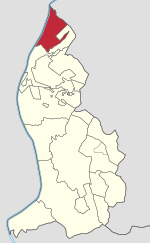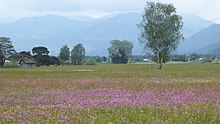Ruggell
Ruggell | |
|---|---|
Municipality | |
 | |
 Ruggell in Liechtenstein | |
| Coordinates: 47°14′36″N 9°31′48″E / 47.24333°N 9.53000°E | |
| Country | |
| Electoral district | Unterland |
| Villages | none |
| Area | |
| • Total | 7.38 km2 (2.85 sq mi) |
| Elevation | 433 m (1,421 ft) |
| Population (31-12-2019)[1] | |
| • Total | 2,322 |
| Time zone | UTC+1 (CET) |
| • Summer (DST) | CEST |
| Postal code | 9491 |
| Area code | 7010 |
| ISO 3166 code | LI-06 |
| Website | www.ruggell.li |
Ruggell is the most northerly and low-lying of the Liechtenstein communities/municipalities, with population of 2,322 in 2019.[1]
History
The name is said to be from the Latin for "clearing the land" (roncale - ad roncalem). Most known for conservation areas and the historic St. Fridolin's Parish Church.
Geography
While Liechtenstein is known as a largely mountainous country, Ruggell is largely flat and is situated along the Rhine River, where the international borders with Switzerland and Austria meet.
Flora and fauna

On the north side of the Eschnerberg mountain located about 90 hectares natural reserve Ruggeller Riet, rich in fauna and especially in flora.[2] [3] This bog was created after the melting of the Rhine Glacier about 16 500 years ago and the subsequent formation of the Lake Constance. The peat mining that had been significant probably since the 19th century started to declined after the Second World War. Of the original 100 peat huts, 12 were still standing in 1982. [4]
The great biodiversity of the Ruggeller Riets includes peat moss, moor grass, Kleinseggenrieder and bogrush. At the end of May to June the siberian iris blooms in the large parts of the nature reserve. [3] 736 plant and 1631 animal species occur in the Ruggeller Riet, among them the white stork and the eurasian curlew, which has disappeared as a breeding bird since 1997. [4]
The Ruggeller are popularly called "Lättaknätter". The loamy soil that occurs here is called "Lätta". In the past peat was used to heat houses during cold season. This ancient tradition has increasingly disappeared in recent years. [5]
Sport
Municipality is famous for FC Ruggell, one of the best teams in the country, although it plays in the sixth division of Switzerland. In other sporting areas cycling, field hockey, skiing and other winter sports stand out. In addition, the town of Ruggell has one of the four sports halls of Liechtestein: the others are in Schaan, Vaduz and Balzers.
Notable people
- Klaus Tschütscher (born 1967) a politician from Liechtenstein, twelfth Prime Minister of Liechtenstein 2009–2013, lives in Ruggell.
- Marcel Tschopp (born 1974 in Ruggell) a Liechtensteiner orienteer and track athlete, specializing in the marathon; was Liechtenstein's flag bearer for the opening ceremony of the 2008 Summer Olympics
- Benjamin Büchel (born 1989 in Ruggell) international footballer who plays for FC Vaduz.
References
- ^ a b Bevölkerungsstatistik
- ^ Unique flora in the Rugeller Riet
- ^ a b Naturschutzgebiet Ruggeller Riet. On the website of the municipality of Ruggell, accessed on 16 June 2019
- ^ a b Nidija Felice, Anna Merz: Ruggeller Riet. In: Historisches Lexikon des Fürstentums Liechtenstein
- ^ Turf fires - burning peat. Cooking and living with peat fires.
External links
![]() Media related to Ruggell at Wikimedia Commons
Media related to Ruggell at Wikimedia Commons
- Official website (in German)

